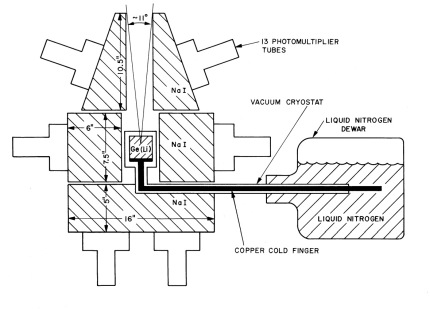Purpose of the flight and payload description
The Bell / Sandia gamma ray telescope was born in late 1973 when a joint Bell Laboratories-Sandia Laboratories group was organized for the purpose of doing nuclear gamma-ray line astronomy from a balloon platform, employing a large-volume lithium-drifted-germanium [Ge(Li)] crystal as the primary detector. The original scientific motivation for the project came from theoretical calculations concerning explosive nucleosynthesis in supernova and nova detonations and also from the galactic center observations of other scientific groups.
The figure at left shows a schematic diagram of the instrument (click to enlarge). The gamma-ray telescope was designed around the largest single Ge(Li) crystal commercially available: a cylinder about 6.3 cm in height and about 4.7 cm in diameter with an active volume of about 92 cm3. A 30 liter liquid-nitrogen Dewar was used to cool the detector to 85 degrees kelvin. The unit was modified for additional mechanical strength and was able to maintain the detector cooled for up to four days of flight. Surrounding the central detector assembly were 184 kg of active Nal in three sections. These shield crystals were operated in anticoincidence with the Ge(Li) detector and served to ensure that only full-energy events in the Ge(Li) were analyzed, while also acted as a collimator defining the field of view of the telescope and finally shielded the detector from the large atmospheric gamma-ray background. All the Ge(Li) pulses that were not vetoed by the shielding system passed through a preamplifier and a shaping amplifier, were analyzed by an analog-to-digital converter and stored in a memory module specifically designed.
The gamma-ray telescope was mounted on an azimuth/elevation mount. Power was applied to the elevation drive system only when the pointing angle was updated. The remainder of the time the elevation angle was fixed with respect to the payload. The orientation of the payload with respect to the gravity vector was sensed during flight by inclinometers. The azimuth of the telescope was actively controlled by using a servo loop and a single-axis magnetometer as a sensor. Restoration torque was provided by a direct drive DC motor, which torqued against the outer frame of the gondola. Inertial damping was provided by a single-axis rate gyro. The azimuth angle was changed by rotating the magnetometer with respect to the telescope. Power was applied to the magnetometer rotation servo only when the azimuth angle was updated. When tracking a celestial target, the telescope mount was updated periodically because of the diurnal rotation of the Earth and the movement of the balloon.
The collection, storage, and transmission of gamma-ray spectra by the payload depended upon information transmission and processing through two radiofrequency links: the up-link, or command system, and the down-link, or telemetry system. The command link consisted of a 100 watt FM transmitter operating at 416.6 MHz and a receiver mounted in the payload while the telemetry link consisted of two 3 watt FM transmitters on the payload at frequencies of 230.4 and 248.6 MHz. The communication system had a range of about 700 kilometers. All the interactions between the scientists and the payload in flight were controlled by the operators through the ground-station computer.
Details of the balloon flight
Balloon launched on: 4/15/1979
Launch site: Australian Balloon Launching Station, Alice Springs, Australia
Balloon launched by: National Scientific Balloon Facility (NSBF)
Balloon manufacturer/size/composition: Zero Pressure Balloon Winzen 594.654 m3 (15.24 microns Stratofilm)
Flight identification number: 156N
End of flight (L for landing time, W for last contact, otherwise termination time): 4/15/1979
Balloon flight duration (F: time at float only, otherwise total flight time in d:days / h:hours or m:minutes - ): F 16 h 10 m
Payload weight: 1672 kgs
External references
- Gamma-ray lines and continuum radiation from the galactic center direction Astrophysical Journal, Part 1, vol. 240, Aug. 15, 1980, p. 338-343
- National Scientific Balloon Facility Annual Report FY 1979 National Center for Atmospheric Research, September 1980
4734If you consider this website interesting or useful, you can help me to keep it up and running with a small donation to cover the operational costs. Just the equivalent of the price of a cup of coffee helps a lot.


